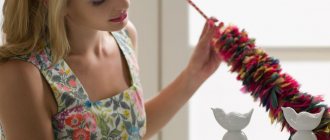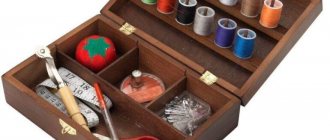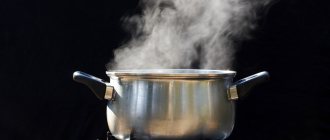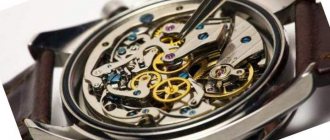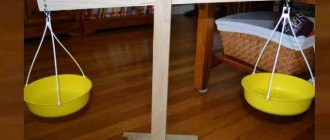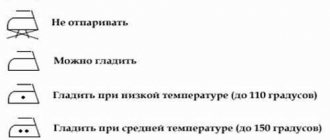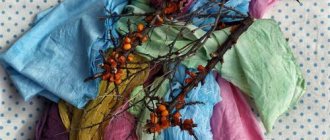Often, after washing and drying knitted items, the owner wonders how to make it dry and clean. By the way, it can be given a neat appearance, because it cannot be ironed like a regular fabric product. In this case, it should simply be steamed; it is quite easy to do even for a person who rarely stands behind an ironing board.
If you wash the finished product, the loops will lie flat; this is necessary when the fabric has an unkempt appearance. This is very often observed among beginners, the hand is not trained and the loops come out of different sizes.
Also, after steaming, the knitted fabric becomes elastic and after that it is easier to sew. In knitting studios they always said: “After steaming, the product acquires a marketable appearance.”
You will need:
- Iron
- A piece of gauze fabric
Attention! Before steaming a knitted item, be sure to test the steaming process on a knitted sample. Instructions.
1. To steam at home with an iron of the previous generation, that is, one that does not have any other modes other than the direct ironing mode (such irons still exist), set the iron’s heating sensor to the maximum temperature.
2. Carefully lay out the knitted item prepared for steaming on an ironing board or other flat surface (first place at least a blanket folded in four under the item if steaming will not be carried out on a special surface of the ironing board).
3. Moisten the pre-prepared piece of gauze cloth generously with water and wring it until slightly damp, through which the steaming will be carried out.
4. Place a piece of gauze on top of the knitted item.
5. Take the heated iron in your hands and bring it as close to the surface of the gauze as possible without touching it. The distance from the sole of the iron to the gauze should be about 0.5-1 cm.
6. Gently move the iron over the surface of the damp gauze. In this case, the water from the gauze will evaporate, and the threads of the product will acquire a neat appearance. You can also use an iron with a steaming function. To do this, pour water into the special compartment of the iron, set the steam mode and move the iron over the surface of the knitted item.
In especially difficult cases, you can use the steam boost function, in which a strong jet of steam is supplied from the sole of the iron to the item you are steaming, which then takes on the appearance of a neat product.
If the knitted pattern does not disturb the shape of the product part, then the paired parts are pinned together and steamed with a hot iron on a very soft mat through a damp cloth. They steam it, not iron it! DO NOT move the iron, just touch it.
Some designs distort the shape of the part, narrower or smaller than the given pattern. In such cases, the knitted part is pinned onto the pattern with the wrong side up and it is steamed in this form, then you need to leave the part to dry directly on the pattern.
A soft bedding is necessary for steaming so that the pattern does not flatten.
It is not recommended to steam very convex designs (braids, cones).
It is better to wash and wring out parts with such patterns, then place them on an absorbent backing. Place the pattern of this part on top and straighten the part along the pattern. Let dry.
Only after these procedures begin assembling the product.
Product assembly.
Next you need to sew the parts, this can be done in several ways:
1. We sweep ironed items with bobbin threads along the wrong side “over the edge”. During the sweeping process, simultaneously plant along the shoulder lines and side lines. Next, the parts need to be sewn on a sewing machine. Remove the basting thread.
2. Shovza needle, or seam “stitch”.
In appearance it resembles machine stitching.
The seam behind the needle is very often done by craftswomen; such a seam is practically invisible, but the disadvantage is that small extra edges remain, and that this seam is not elastic.
Such a seam can be made both from the wrong side and from the front side of the product.
On the wrong side we sew the seam like this:
We put together two parts with the right sides inward, and sew on the wrong side according to the diagram. It is better to take the thread that was used to knit the main product and insert it into a needle with a large eye and a rounded end. If possible, make small, even stitches of the same length.
On the front side, such a seam is made when there are open loops. The figure shows an example of such a seam when connecting horizontal and vertical knitting.
3. You can manually sew the parts on the front side .
This seam is done correctly and is completely invisible. There are several options for making such a seam, the implementation of which is shown in the pictures.
The first method: “stick the needle inside the edge loop”
Second method: “by pulling”
4. Hems along the bottom of skirts and dresses can be hemmed with a buttonhole stitch, but it should be crocheted. To do this, bend the part along the loop column, so that its direction is from left to right. Crochet a row (half column) from right to left in each loop of the loop column.
Steaming method from Semir @ mid @ .
I put gauze in a bowl of water. I turn the iron on to maximum heat. I lay out the part on the table. The gauze is lightly wrung out and applied to the part. With one hand, lightly touching the gauze, I move it over the product. My other hand is under the gauze and carefully straightens the edge of the product. After one such “travel” through the part, it becomes almost equal. I move the iron over the part until the gauze dries out a little. Then, carefully, with both hands, I lift the part and move it to a place where it, along with other parts, can lie until it dries. It is important to remember that a moistened and hot part can be easily deformed. To avoid this, I lift the piece by inserting both hands, palms up, so that the piece rests on the area up to the elbows.
Steaming method from Lisi.
Instead of pinning the knitted parts on a pattern, I place them on a fluffy bath towel (if it’s openwork, then it can be face up, if the pattern is more or less convex, then it’s wrong side up), the steam in the iron is at maximum, I cover the parts with double or triple gauze and without touching I steam the parts at a distance of 1-1.5 cm, I did the same with acrylic, but the size increased slightly. After sewing the seams, I also steam them through gauze without touching them with an iron. As steaming progresses, remove the gauze frequently and straighten the outline of the part. In my experience, this is the most successful way to steam.
You can read more about steaming on the Osinka forum.
How to steam a knitted product
The beauty of a knitted product largely depends on the quality of the yarn. But it looks truly finished after steaming or wet heat treatment (WHT). It is performed using an iron with a “steam” function and a piece of gauze or fabric. We also always steam the finished knitted product using an iron and damp gauze or cloth.
If the product is knitted independently, then the yarn itself is steamed first. Especially if it is reused after the dissolution of the previous item. This is necessary to straighten the caked thread. Then a control sample is knitted and also steamed. This is necessary in order to understand how the yarn will behave in the finished product. The next WTO will be needed for the details of the knitted item. We pre-baste the sleeves together so that they are the same size. If the knitting is stocking, we connect it close to the edge so that the part does not curl into a tube. We baste the front and back separately, folding them in half along the vertical fold. Steam carefully without touching the vertical fold.
We carefully hold the iron in weight. Under no circumstances should you iron knitwear or press on it, as is the case with regular fabric. This will cause deformation. The gauze must be constantly damp. During steaming, it can be moistened several times. Do not dry the steamed knitted parts with an iron completely. At the end of the WTO, they should be slightly damp and dry on their own.
If the yarn is unstable, the knitting structure is loose, then the details of the future product must be pinned with stainless pins to the pattern on the fabric. We attach the paper pattern to a piece of fabric and trace the outline with a permanent marker. Then we pin the details of the knitted item to the contours of the pattern.
When the knitwear pattern has a raised convex pattern, a terry towel should be placed under the piece in front of the WTO. Openwork parts with holes are carefully stretched to the desired size before steaming.
After assembling the product, we also lightly steam it through a damp cloth or gauze, holding the iron suspended. We pay special attention to seams and folds.
The same steaming rules apply to finished knitted items. They are also pre-laid out on an ironing board, smoothing out dents and creases with your hand. Steam through damp gauze using a steam iron. Hold the iron above the surface of the product.
Under no circumstances should you steam the elastic; it will stretch and lose its shape. Otherwise, the finished knitted product will have to be remade, and the hand knitted product will have to be re-knitted. If the item is knitted from thick, harsh yarn, then before the WTO we moisten not only the gauze, but also the product itself.
Several subtleties and features of steaming. If the product is made of wool, there is practically no need to steam it. You can do a minimal WTO, then wrap the knitted item in a terry towel for a few minutes. Unfold and leave in a horizontal position until completely dry.
Knitted items made from cotton yarn should be steamed carefully, without being particularly zealous. Cotton often leaves yellow stains from hot water; under the influence of high temperatures, cotton items can shrink significantly. When performing WTO, you can lightly starch them with an aerosol agent. It will give the knitted product the necessary shape.
Knitted items made from bamboo yarn are very pleasant to the body and environmentally friendly. But she is capricious and easily loses her shape. You don’t have to steam the finished item at all, but dry it immediately in a horizontal position after washing. If a WTO is necessary, then you need to move it very carefully; the iron does not need to be heated too much. Otherwise, the product may become deformed.
Knitted items made from silky or lurex yarns should be steamed carefully. Do not set the temperature regulator on the iron to maximum. Otherwise, the threads may melt and the item will be damaged.
Steam acrylic knitwear very carefully. Or don’t do this at all, laying the item after washing horizontally on the surface until completely dry. Otherwise, the “capricious” thread may become deformed and the shape will be lost.
Delicate openwork items are best steamed without an iron. Pour water into a saucepan and heat it up. When the water boils, remove the lid. Carefully, so as not to scald your hands, hold the mohair product over the steam. Folds and creases are smoothed out, mohair fibers are straightened and fluffed up. Small knitted parts and finishing elements can be steamed over the spout of a boiling kettle. This is a proven folk method.
Before the steaming procedure, be sure to test the knitted product. When knitting yourself, this does not cause any difficulties. You can try it on a sample. If you need to steam a finished item, you should definitely test it on the inside out so as not to spoil it.
When steaming knitted items at home is in doubt, it is better to trust dry cleaning. There, the product will be carefully and carefully steamed using special equipment.
How to properly steam a knitted product with knitting needles
You probably have preserved in your memory the lovely items knitted for you personally by your grandmothers, mothers and even great-grandmothers. Such things are sometimes stored for a long time not only in our memory, but also on a separate shelf, as a special memory of our childhood. But knitting is quite relevant now.
But over time, our lives also improve. A device such as a steamer has firmly strengthened its position in most homes, where preference is given to it rather than an iron. This is true - the device smooths out wrinkles much more efficiently, and the process takes much less time. But knitted items also sometimes need ironing, since wrinkles of threads are a natural phenomenon. That’s when the question arises: “How to steam a knitted item?”
How to properly steam a knitted item
Many modern mothers prefer just such products for their children. They can be knitted yourself, or they can be ordered from craftswomen in the city. But not only children's things can be knitted or crocheted. Many people prefer knitted items in their wardrobe. Scarves, cardigans, hats, skirts, vests, sweaters, tunics, jackets, openwork capes and much more - all this can be knitted yourself.
Naturally, all this is not always stored hanging in the closet on a hanger, but in most cases it is folded on shelves. This is where folds and creases appear on the threads. And if you are the happy owner of such a miracle device as a steamer, then you can deal with the problem in a few minutes.
In addition, steaming will give clothes a neat appearance and prevent further shrinkage, stretching and deformation of the threads.
Rules for using a steamer for knitted items
- Steaming occurs only in a vertical position. Hats, berets and any other headwear must first be placed on a jar or other similar shaped object.
- To align the product along the seams, you can use pins or small stationery needles.
- Products made from cotton, viscose, and linen can be steamed without gauze, but wool and acrylic threads require additional coating. Products made from coarse yarn can be moistened with a spray bottle directly onto the surface of the threads.
- After completing the process, do not immediately put the item on a shelf or in a closet. Let it cool completely.
How to steam things with a steam generator
The steaming sequence is quite simple:
- hang the product in a vertical position on a special stand;
- heat the device and set the steam power to medium;
- walk over the surface, paying special attention to individual areas that have the most folds;
- if the power is not enough and there are still creases on the product, increase the temperature;
- try not to move the iron too closely across the material; the optimal distance is up to 10 cm.
That's all the rules regarding steaming knitted items. Follow simple recommendations and your clothes will retain their attractive appearance for a long time and will not lose their shape.
If you are interested in crocheting or knitting, then you already know that after finishing the work you need to steam the knitted item so that the item looks neat and does not shrink or stretch in the future.
In addition to finished products of simple products, you also need to steam individual finished knitting elements (for example, when knitting a sweater, these will be the sleeves, back and front). With openwork knitting, this procedure helps straighten out all the elements and patterns on the product.
The further appearance of the product depends on proper steaming. You need to steam carefully, otherwise you can deform the item. By and large, steaming is not at all difficult, you just have to follow a few rules. Find out the properties of the yarn you are using - not all threads will withstand exposure to high temperatures.
Even if you are confident in the yarn, practice on a swatch before you begin. Yarn can be of different quality, so even if you have already worked with similar material, it would be a good idea to check.
Machine washable
In order to wash knitted items in a washing machine correctly and without damage, you need to perform a number of steps:
- Place the product in a special laundry bag: it will prevent deformation and stretching.
- Pour or pour detergent and rinse conditioner into the tray.
- Set the temperature on the machine - +30°C - +35°C and the required mode (delicate or hand wash).
- The type of spin should also be considered: it should be at minimum speed or completely absent.
How to steam a knitted product without ruining it?
It is much easier for modern housewives to care for knitted clothes. Nowadays, everyone has irons with an additional “steam” function. But this method can only process products made from viscose, cotton or linen threads - the so-called “summer knitting”.
First, you need to lay out the item (or its element) on a flat, soft surface (ironing board) without folds or unevenness. To give the desired size and shape, pin the edges.
Woolen items should be covered with wet gauze or a towel and ironed. The iron should be held suspended and should not be “pressed” on it (as when ironing ordinary fabric). The gauze or towel should be kept damp at all times. You can moisten them several times during steaming.
If the item is knitted from coarse and thick yarn, then we moisten the product itself. If you have a steam generator at home, then you no longer need to use a damp cloth.
Steam processing of products
Once the item has dried, it needs a wet heat treatment (WHT) and in most cases cannot be ironed. To give the item the correct shape and align the loops in its knitting, only an iron with a “steam” function or a clothes steamer is suitable.
The product must be carefully laid out on the surface of the ironing board and covered with clean gauze or cotton cloth, previously slightly moistened with water. After this, the item must be steamed using either the “steam” function on the iron or a steamer. If the item has just been knitted, then an OBE should be performed immediately after the end of knitting. This way the canvas straightens, the loops are made smoother, and the product takes on the shape that was originally intended.
If for some reason you don’t have a “new generation” iron at hand, but you still need to iron a knitted product, any iron will do. However, you will have to act very carefully so as not to burn a hole in the knitted fabric or leave scorch marks.
In the same way, you need to lay out the item on the ironing board and cover it with a clean piece of gauze or cotton fabric. After this, use a spray bottle to spray clean water onto the entire surface of the fabric. Next, turn the iron lever to the maximum temperature, and, holding it very close to the product, but without touching it, move it over its entire area. This action requires great care and concentration, but the result, if you did everything correctly, will be exactly the same as if you used a steamer.
When steaming knitted or crocheted items, you should pay attention to the seams, if any. It is necessary to steam them in such a way that unsightly creases do not form at the places where the parts of the product are sewn together.
If there are no seams on the items (for example, on sweaters and dresses knitted with raglan both at the top and bottom), they need to be steamed so that there are no folds on the sides. It is best to carefully pull the product onto the ironing board and sequentially treat it with hot steam on all sides. If the stitching was done using a knitted stitch “loop to loop” (most often found on handmade items), then their smoothing is done in the same way.
If you use a vertical steamer to steam your knitwear, you can not lay the items on the ironing board, but after drying, hang them on clothes hangers. Steaming can be done directly on them. It must be remembered that by leveling the surface of clothing in this way, you make it wet, and after completing this procedure you need to let things dry.
This is important: APPLICATIONS FROM COTTON PADS
If the product is not knitted from natural wool or cotton (this is most often found in industrial production), for example, sweaters or scarves made of acrylic, there are some peculiarities in caring for it. Since this material is one hundred percent synthetic fibers, it gets dirty faster than natural ones. Wash it in water no hotter than 40 degrees. If you do this by hand, under no circumstances should you wash out stains that have formed on your clothes. They should be carefully rubbed with stain remover soap and left for the time recommended in the instructions. After this time, you need to carefully rinse the item and squeeze out as little excess water as possible.
Final wet-heat treatment (WHT) of the sweater. Stages 2 and 3.
If you wash acrylic in a washing machine, it is better to select the wool or delicate wash mode and set the spin speed to the minimum. You can use both washing powder and washing gel. But bleaches – either alone or as part of a laundry detergent – cannot be used.
As for steaming items made of acrylic, they, like items made of bamboo thread, cotton or lurex, are very easy to spoil. Therefore, WTO should not be carried out at the maximum temperature of the iron. As for cotton threads, they tend to shrink strongly during steaming; in addition, it is very easy to place a stain on them with hot steam, so WTO is carried out quickly and with a non-hot iron.
To learn how to steam a knitted item, watch the following video.
How to steam a knitted product - tips:
Steaming has its own subtleties and features. For example, if the product is knitted from wool, then there is no need to steam it at all. It is enough just to wash the item and wrap it in a terry towel for just a couple of minutes. Afterwards, you need to unfold it and lay it out on a flat surface so that it completely dries.
To steam the caps, you need to put them on something that matches the shape and size of your head (usually glass jars are used for this). In this case, it is more convenient to use a steam generator rather than an iron.
Knitting from cotton thread should be steamed most carefully; sometimes excessive temperature can leave a yellowish tint on the white thread. Plus, at high temperatures, cotton items can shrink significantly. To give a better appearance, such things additionally need starching. Today, you can use special convenient aerosols for this.
If you knitted from silky yarn, then such a thing needs to be steamed very carefully. On the iron, set the regulator to the “silk” position; at high temperatures, you can irreversibly damage this type of yarn.
For openwork mohair knitting, it is better not to use an iron at all - there is a proven folk method for this. Heat a pot of water on the stove until it boils. Next, you need to carefully hold the openwork product over boiling water. The fibers of the yarn will smooth out and become “fluffy”, creases will straighten out. It is enough to hold finishing elements and small knitted parts over the spout of a boiling kettle. If you have a steamer, the procedure will be much easier.
If the product becomes deformed during the steaming process, you can try washing it on a delicate cycle and at a temperature of 40 degrees. It is important to know that you need to wring it out manually, since doing this in a washing machine is contraindicated.
When you have doubts about steaming knitted items at home, the best option would be to trust dry cleaning. There your item will be steamed correctly using special equipment.
A knitted item, as a rule, is a must-have in any wardrobe. Self-knitted products are now at the height of fashion. But knitting an outfit is still half the job. The finished product needs to be given a marketable appearance. It becomes completely finished only after undergoing wet heat treatment (steaming). This treatment will help avoid possible shrinkage, deformation and stretching. Therefore, for many, especially beginner knitters, the relevant question is how to steam a knitted product.
How to iron a cardigan?
Cardigans can be ironed. This is usually done from the wrong side through a damp sheet. The iron should be set to a special temperature setting for wool or the 110º mark. If there are no relief patterns on the cardigan, then you can use the steaming mode.
Interesting materials:
What do the numbers on shrimp mean? What does 1x2 mean for regular time? What does 1X2 mean in hockey? What does 2u mean on a train ticket? What does 2v on a pencil mean? What does the 3rd lunar day mean? What does the 4th quarter of the year mean? What does 4 on diapers mean? What does 4 ohms mean on speakers? What does level 4 accreditation mean?
Wet heat treatment
In addition to ready-made knitted products, it is also necessary to steam finished knitting parts. For example, when knitting a sweater, we steam the sleeves, back, and front separately. You need to act carefully so as not to deform the knitted fabric.
In fact, steaming things is not at all difficult if you follow some rules. It is necessary to learn everything about the properties of the yarn used; not all threads withstand high temperatures equally well.
Even if you are confident in your abilities, it is worth practicing on a small sample before starting work.
Before knitting from threads that were unraveled from an old product
If you decide to knit from threads that were already in the product, then you must first wash them.
When unraveling an old knitted item, tie the threads with a weaver's knot so that the knot does not come undone during the washing process.
We wind any yarn - wool, cotton or synthetic - into skeins before washing.
In order to wind threads into a skein, there are now special devices, or you can use the back or legs of chairs. After you have made a skein, you need to tie it in several places so that the yarn does not get tangled during the washing process. We tie it with a simple white thread so that the threads do not fade during the washing process.
Next, gently soak the yarn in a warm soapy solution. It’s clear that we don’t rub it or twist it.
It is important to rinse until the soap disappears completely, otherwise you may get smudges on the yarn. Moreover, this is also true when rinsing finished knitted products, and not just the threads themselves.
After washing, let the water drain and carefully lay it out to dry at room temperature, for example, on a terry towel. Moreover, it is better to have 2 or even 3 towels and change them as they become saturated with water.
After the threads have completely dried, we wind them into a weak, weak ball. Then they do not stretch out and remain fluffy. By the way, this is the best way to store threads, clean and in balls.
If, after unraveling a product made from woolen threads, you do not wash them, then over time they will be eaten by moths .
